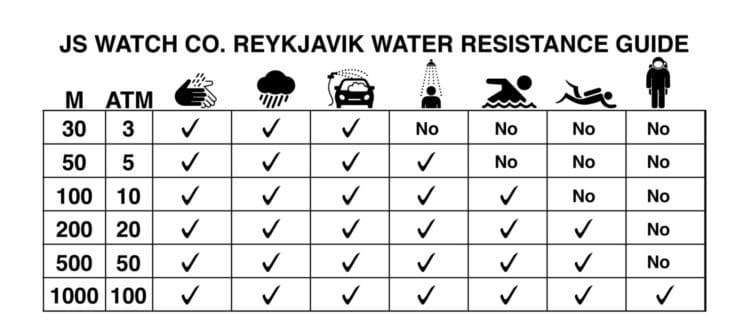How a Watch Water Resistance Test Is Performed

Watch water resistance is a wide and often perplexing topic for watch owners. With so many watch brands and case constructions to choose from, it can be a challenge to choose one that fits your lifestyle. When it comes to adding water resistance to this, it becomes an even harder decision. With that in mind, we have put together a guide to help you understand more about water resistance in watches and how the specific watch water resistance test is carried out.
What Is Does it Mean When a Watch is Water Resistant?
Knowing the watch water resistance of your chosen timepiece doesn’t mean you can keep your watch underwater indefinitely – this is an important note. Water resistance is not the same as waterproof, and therefore, it’s crucial not to get your watch too wet, even if there is water resistance present.
With watches, you’ll find the manufacturer’s water resistance rating etched onto the back of the case. This water resistance rating is based on a set of highly controlled tests carried out in a laboratory. However, normal wear and tear, as well as the age of the watch, will reduce the watch’s water resistance with time.
Please bear in mind that after the battery has been replaced, the seal that protects the watch from water will no longer be functional. We highly advise you to always follow the manufacturer’s instructions. That includes having your watch inspected at least once a year or after a battery replacement to guarantee that water does not penetrate the watch case.

How Water Resistance is Measured?
In watch water resistance test the resistance to water is measured in bars. A bar is a measure of pressure, with one bar equaling one atmosphere (ATM), and watches are checked at these pressures in a static air laboratory test for a short period of time. So essentially a water resistance test simulates the amount of pressure at a given depth.
Water resistance is translated differently based on the manufacturer. Water resistance is often measured in terms of bars, feet, meters, or atmospheres (ATM) in a static posture, thus 3bar, 3ATM, and 30 meters are all the same.
Moving a watch that is already submerged in water substantially puts more pressure on its components, even if the device is in shallow water, reducing its water resistance. The watch does not have to be submerged to the stated maximum depth.
The Lab: Is It The Right Place For a Watch Water Resistance Test?
As we’ve mentioned above, standard manufacturer’s watch water resistance checks are done in a lab. They use specifically designed and perfectly controlled conditions. The problem with this is that you won’t be wearing your watch in a lab – you’ll be wearing it in real life. That means other factors have to be considered, which might not be part of the original water resistance test.
For example, water temperatures from a hot tub or a hot shower may cause the formation of the gasket seals to expand slightly. When a watch is removed from hot water and immediately placed in cold water, the gaskets are known to expand and shrink. This is just as it would when coming from a hot tub and immediately jumping into a pool).
Rapid pressure fluctuations, such as diving into a pool, can also put a strain on the watch components, even if only for a fraction of a second. If the gaskets are not up to standard, they can burst and let water into the watch. Plus, the older the watch, the less functional those seals will be.
How Do We Test For Watch Water Resistance?
During a water resistance test, the watch is put into a half-filled cylinder that contains water and air. The air pressure in the chamber is raised, and the watch is dropped into the water. The air pressure within the chamber is reduced after the watch is fully submerged. If bubbles emerge from the watch, this indicates that air has gotten into the watch prior to immersion, and the watch is not water resistant. This test can also be used to find any water leaks in the watch casing so that you can repair or replace components to guarantee the watch is water resistant.
Some watches are made to be highly water-resistant at tremendous pressures than others. Some are made without any kind of watch water resistance at all. Understanding the difference and knowing what you need in terms of the functionality of your watch is crucial. In this way, you can choose the right watch for you with complete confidence that you not only made the right choice, but that your watch can be kept safe and protected in your everyday life.
Recommended Upkeep to Maintain Water Resistance
Getting your watch serviced regularly is one of the best ways to ensure your watch remains water resistance. When you service your watch they will check to ensure the gasket is sealing the watch case. Another recommendation is to have your battery changed by a professional and ensure they do a watch water resistance test. Lastly I would advise that you regularly monitor and inspect the timepiece.






 Our mission is to help people find local watch repair shops and authorized service centers. As avid collectors we understand how to find trustworthy services that can keep your precious timepiece both functional and beautiful.
Our mission is to help people find local watch repair shops and authorized service centers. As avid collectors we understand how to find trustworthy services that can keep your precious timepiece both functional and beautiful. 
